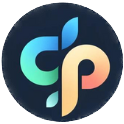AI Custom Coloring Pages Your Kids Will Love
July 2, 2025
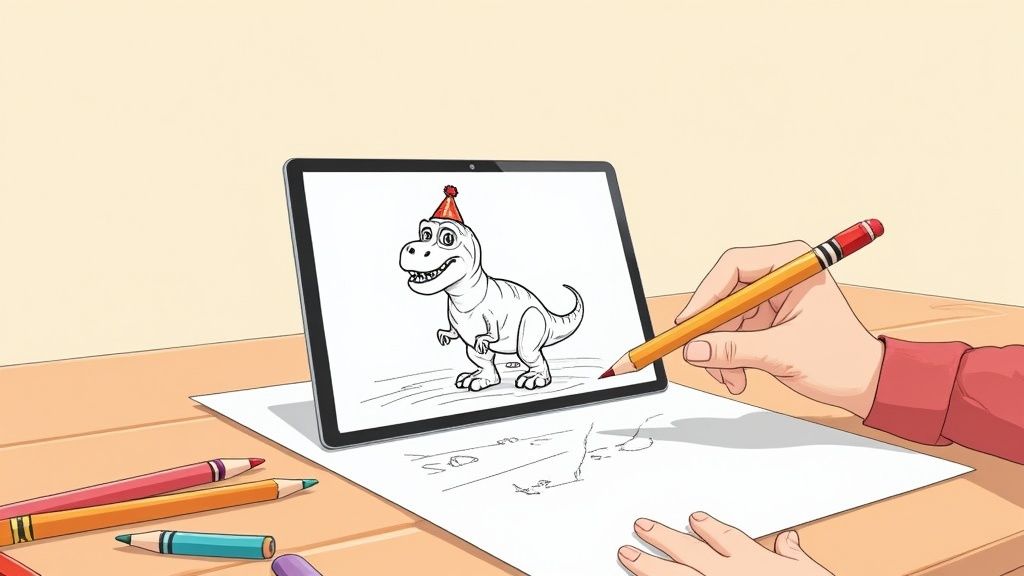
Forget those generic, store-bought coloring books.
What if you could create a one-of-a-kind coloring page of your dog as an astronaut? Or bring to life that magical, sparkling forest from your child's imagination? That's the real fun of making custom coloring pages with AI.
Turn Your Ideas into Unique Coloring Pages
This guide is your launchpad for turning simple ideas into beautiful, printable art that is completely, uniquely yours. We’ll walk through why this has become such a popular creative outlet for families and a genuinely fantastic tool for mindfulness.
You'll see just how easy it is to get started, transforming those creative sparks into something tangible and fun.
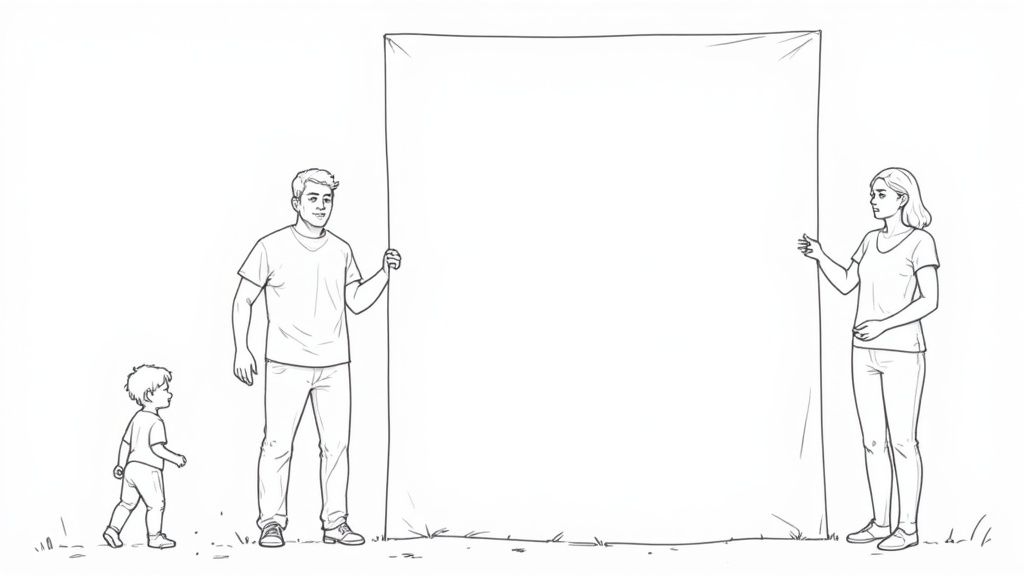
This whole process offers a perfect escape from screen time and the daily grind, giving you a moment of pure creative peace. It’s wonderfully straightforward: you just provide a simple text description, and an AI tool generates a unique coloring sheet just for you.
Why Is Everyone Coloring All of a Sudden?
This trend isn't just for kids. Adults everywhere are picking up coloring as a powerful form of self-care. The skyrocketing demand for adult coloring books is proof—the global market hit about USD 151.23 million in 2024.
And it’s not slowing down. That market is projected to more than double by 2030, all thanks to a growing focus on mental health and finding new ways to beat stress.
This explosion in popularity points to a universal need for creative outlets that are both easy to get into and incredibly rewarding. Custom coloring pages just take that to the next level by making the whole experience deeply personal.
The real magic happens when you move beyond pre-made designs and start creating pages that reflect your own life, interests, and inside jokes. This personal connection is what makes the activity truly special.
Kicking Off Your Creative Vision
Let's be honest, the biggest hurdle for a lot of us is just coming up with an idea. What do you actually want to color? The possibilities are so endless it can feel a little paralyzing at first.
Before you jump into the AI tools, it can be super helpful to explore some good methods for how to generate ideas and get those creative juices flowing.
Need a little nudge? Here are a few starting points to kickstart your first custom page:
- For Family Fun: Turn a family photo into a cartoon-style page or create a scene from your kid's favorite bedtime story.
- For Personal Relaxation: Design intricate mandalas that weave in meaningful symbols or patterns you find calming.
- For Educational Purposes: Generate pages that help with learning, like an alphabet series where each letter features a different animal ("A is for Alligator," "B is for Bear").
- For Unique Gifts: Create personalized birthday or holiday cards that friends and family can color themselves. It’s part gift, part activity!
The beauty of this is there are absolutely no rules. Your imagination is the only thing setting the boundaries. Whether you want a simple design for a quick 10-minute activity or a complex piece of art to lose yourself in for hours, you're in complete control.
Find the Right AI Art Generator for Coloring Pages
Let's be honest: not every AI art tool is built for making clean, crisp coloring pages. Many are phenomenal at generating breathtaking, painterly images but completely fall apart when you just want simple, bold outlines. Picking the right tool is the first and most crucial step to making this whole process fun, not frustrating.
You're looking for a generator that gets the unique style of a coloring book. It needs to produce clear black-and-white images with defined edges and minimal shading. Some tools are just naturally better at this than others, and knowing which ones to try can save you a ton of headaches.
What to Look For in a Coloring Page Generator
When you start exploring different AI art generators, you’ll want to have a mental checklist of features that are specifically helpful for creating line art. Some platforms have even made it easy by including pre-set styles like "coloring book" or "line art," which is a huge timesaver.
Here’s what I focus on:
- Line Quality: Does the AI spit out smooth, solid lines, or are they all sketchy and broken? You need clean lines that are easy to color inside.
- Style Versatility: Can the tool jump from simple cartoon animals to intricate floral mandalas? A more versatile AI gives you much more creative freedom down the road.
- Ease of Use: Is the platform intuitive, or does it feel like you need a degree in prompt engineering? A clean interface and simple controls make a world of difference, especially when you’re just starting out.
This is a fantastic visual breakdown of what themes people are most excited to create. It really highlights the kinds of pages that are most in demand.
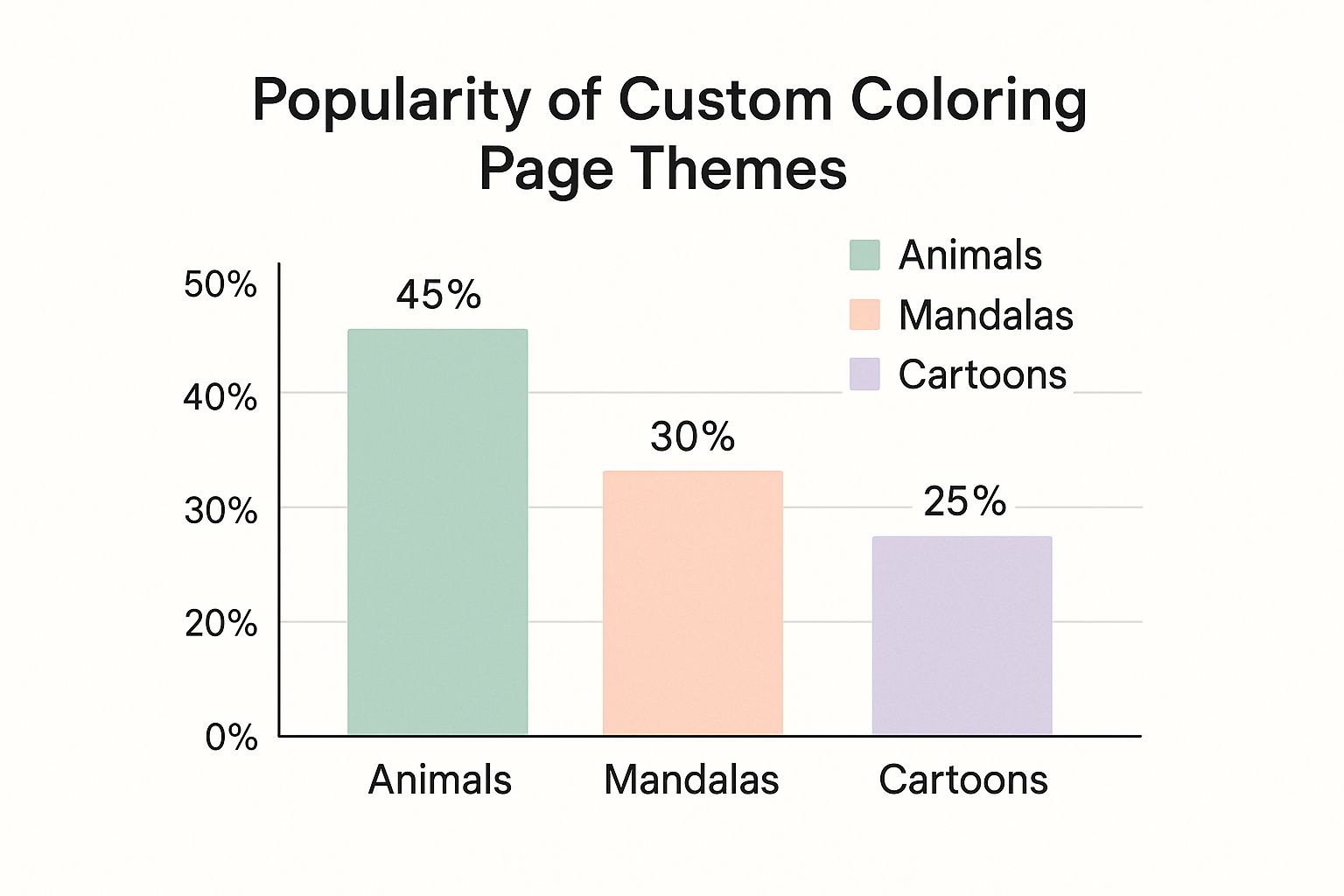
As you can see, animals are the runaway favorite. This tells us people really connect with creating coloring pages of familiar, fun subjects for themselves or their kids.
Free vs. Paid: What’s the Real Difference?
Plenty of excellent free tools can get you started right now. They're perfect for dipping your toes in the water and experimenting without any financial risk. The trade-off? They often come with limits, like a cap on how many images you can generate or lower-resolution downloads.
Paid platforms, such as the wildly popular Midjourney, tend to deliver higher-quality results, more control over the final image, and much better consistency. For a deeper look at using AI for children's activities, you should check out our guide on AI-generated coloring pages for kids.
My advice? Start with a free tool. Get a feel for writing prompts and see what kind of results you get. Once you know what you want to create and start hitting the limitations of the free service, you can decide if upgrading to a paid plan makes sense for your projects.
To give you a better idea, here's a quick comparison of some of the top players in the AI art space.
AI Art Generator Feature Comparison for Coloring Pages
Choosing the right tool can feel overwhelming, so I've put together this table to compare some of the most popular options. This should help you pinpoint the best starting point based on what's most important to you—whether it's ease of use, cost, or getting that perfect line art quality.
| AI Tool | Best For | Ease of Use | Line Art Quality | Cost Model |
|---|---|---|---|---|
| Midjourney | Highly artistic and stylized images | Moderate (Discord-based) | Excellent, but needs specific prompting | Subscription-based |
| DALL-E 3 | Simplicity and creative concepts | Very Easy (Integrated with ChatGPT) | Good, very consistent | Pay-per-generation / Subscription |
| Stable Diffusion | Ultimate customization and control | Difficult (Requires local setup/web UI) | Varies (Highly dependent on model) | Free (Open-source) |
| ColorPage.ai | Specifically for coloring pages | Extremely Easy | Optimized for clean lines | Freemium / Credit Packs |
Each of these generators has its own strengths. If you're looking for a dedicated, no-fuss solution, something like ColorPage.ai is designed from the ground up for this exact task. But if you want to explore broader artistic styles, Midjourney or DALL-E 3 are powerful contenders.
Ultimately, the best AI art generator is the one that fits your specific needs and skill level. Don't be afraid to experiment with a few different platforms to find the one that feels right to you. This initial choice will set the stage for all the amazing custom pages you're about to create.
How to Write Prompts That Create Perfect Line Art
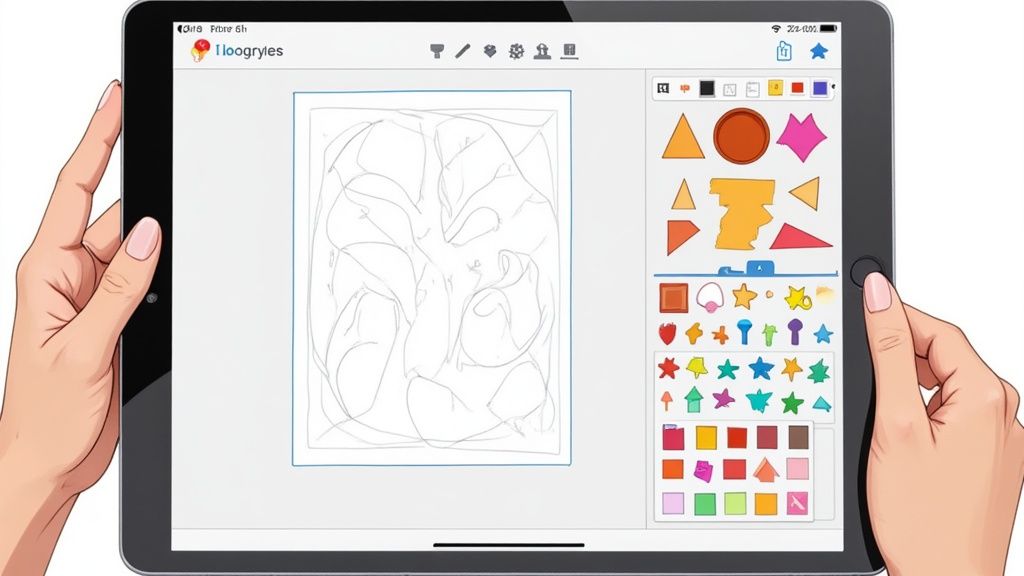
The prompt is your direct line to the AI, and getting it right is the secret sauce. If you just ask for "a cat," you'll probably get a stunning, photorealistic feline—which is beautiful, but completely useless for coloring. Mastering the art of the prompt is how you guide the AI from a vague idea to a crisp, clean, ready-to-color masterpiece.
Your main goal here is to be incredibly specific about the style of the image, not just the subject. Think of it like ordering a fancy coffee. You don't just say "coffee"; you specify if you want an iced latte with oat milk and a caramel drizzle. The same logic applies here. You have to tell the AI you want custom coloring pages, not a digital painting.
Essential Keywords for Clean Line Art
Certain words and phrases are like magic spells for AI image generators. When you sprinkle these into your prompt, you're telling the AI to forget about shading, complicated textures, and color. Instead, it will focus entirely on producing those clean, bold outlines we're after. These are your core ingredients.
I've found these keywords to be the most effective:
- Coloring book page: This is the most direct instruction you can give. It immediately sets the right context.
- Clean line art: This phrase is perfect for emphasizing your need for crisp, solid lines, steering clear of sketchy textures.
- Black and white: You have to explicitly tell the AI to avoid color. It's a fundamental step.
- Simple outlines: Use this to stop the AI from getting carried away with tiny, intricate details or internal patterns.
- No shading: This one is critical for getting a pure outline. If you forget this, the AI will often add subtle gray tones and gradients.
- Vector style: This is a great term that encourages the AI to create the smooth, scalable lines you see in professional vector illustrations.
The real trick is combining these style keywords with a rich, descriptive subject. The more detail you give the AI about both the "what" and the "how," the closer it will get to your vision on the first try.
From Vague Ideas to Perfect Prompts
Let's put this into practice. A recent study found that a whopping 87% of parents believe coloring stimulates a child's imagination. Your prompts are the very first step in creating something that sparks that joy. The difference between a weak prompt and a great one is all in the details.
Weak Prompt Example:
A friendly dragon
This is way too vague. The AI has to guess what "friendly" looks like and will almost certainly default to a full-color, highly detailed illustration.
Strong Prompt Example:
Coloring book page of a cute, friendly baby dragon hatching from an egg, simple bold outlines, black and white, no shading, full body, white background
See the difference? This prompt is jam-packed with specific instructions, leaving very little to the AI's imagination.
Anatomy of a Great Coloring Page Prompt
Let's break down that strong prompt to see exactly why it works so well. From my experience, a successful prompt for a custom coloring page almost always has these key components.
- Core Style: Kick things off with your main instruction.
Coloring book pageorclean line arttells the AI exactly what kind of image you're making. - Subject & Action: Now, describe the what.
A cute, friendly baby dragonis miles better than justdragon. Giving it an action, likehatching from an egg, makes the scene more dynamic and fun. - Stylistic Refinements: This is where you add your non-negotiable keywords.
Simple bold outlines,black and white, andno shadingare must-haves for getting clean, colorable results. - Composition: Finally, frame the shot. Add instructions like
full bodyto make sure you get the whole character andwhite backgroundto keep the image clean and free of random, distracting elements.
When you follow this structure, you're essentially giving the AI a crystal-clear blueprint. This dramatically increases your chances of getting the perfect printable page on the first go.
Polishing Your Image for Printing
Once the AI generator has worked its magic, you've got a fantastic starting point. But to get that truly professional, ready-to-color feel, your new image will almost always need a little polish. This final clean-up phase is what takes your design from a cool digital file to a crisp, high-quality coloring page that’s a joy to use.
This step is all about refining the details. We're going to smooth out any rough edges and make sure the final product is perfect for printing on a standard sheet of paper. And don't worry, you don’t need any expensive software—free tools like Canva or Photopea are more than capable of handling these quick but essential tweaks.
Fine-Tuning Your Line Art
First thing's first: open your image and give it a close look. I've found that AI can sometimes leave behind small imperfections that you might not notice at first glance. These are usually easy to fix and make a huge difference in the final quality.
Here are a few common issues I always check for:
- Stray Pixels or Lines: Sometimes the AI generates tiny, disconnected dots or lines. Just grab the eraser tool in your editor and gently remove these stray marks.
- Gray Shading: Even when you ask for black and white, some AIs add subtle gray areas. Adjusting the contrast is the quickest way to fix this. Crank it up to make the blacks blacker and the whites whiter, which gets rid of those muddy tones.
- Broken Lines: You might spot small gaps in the outlines. You can easily connect these using a simple pencil or brush tool—just set it to black and fill in the gaps to maintain a solid, continuous line.
A simple tweak to the brightness and contrast settings is often the single most effective change you can make. It instantly makes the lines pop and gives the entire page a much cleaner, more defined look.
Upscaling for Crystal-Clear Prints
Now for what is arguably the most important part of prepping for print. The initial image an AI spits out is often a standard web resolution, which can look pixelated or blurry when printed on a full page. To avoid this, you need to upscale the image, which just means increasing its resolution without losing quality.
Thankfully, many modern image editors, including some free online tools, now have AI-powered upscaling features built right in. Look for options like "Upscale Image" or "Increase Resolution." Your goal should be a resolution of at least 300 DPI (dots per inch) for a standard 8.5" x 11" paper size. This is the magic number to ensure sharp, clean lines when you print. For a deeper dive, learning about optimizing images for quality and efficiency can give you an edge in getting the best results.
Taking just a few minutes for these refinements guarantees your custom coloring pages will print beautifully every single time. It's what provides a truly high-quality experience for you, your kids, or anyone you share them with.
Creative Ideas for Your Custom Coloring Pages
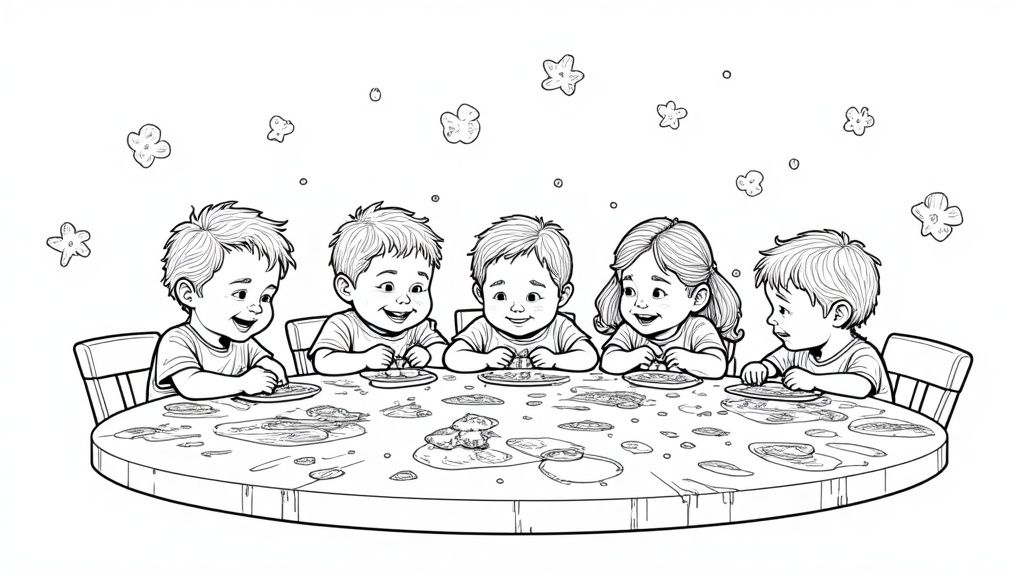 Alright, so you’ve got the hang of prompting and polishing your AI creations. Now for the million-dollar question: what are you going to make? This is where the real fun begins. Forget generic animals and basic patterns—the possibilities for custom coloring pages are as big as your imagination.
Alright, so you’ve got the hang of prompting and polishing your AI creations. Now for the million-dollar question: what are you going to make? This is where the real fun begins. Forget generic animals and basic patterns—the possibilities for custom coloring pages are as big as your imagination.
Think about how you can turn your next get-together into a creative experience. For a kid's birthday party, imagine generating pages that cast the birthday boy or girl as a superhero, a fairytale princess, or even a race car driver speeding toward the finish line. Talk about an incredible party favor that’s both personal and keeps the little ones busy!
Ideas for Every Occasion
The magic truly happens when you start designing pages for specific people or events. You can move beyond one-off designs and create entire themed sets for holidays, family milestones, or just for a bit of fun.
Here are a few ideas to get you started:
- Holiday Magic: Create a Christmas scene starring cartoon versions of your own family—pets included! Or, design a spooky Halloween page featuring a haunted-house version of your own home.
- Educational Fun: Generate a custom alphabet series for your toddler where each letter features something they personally love. Think "A is for Apple," "B is for Banana," and "C is for their favorite Cat."
- Personalized Relaxation: Design intricate mandalas that weave in meaningful symbols, like a favorite flower, a zodiac sign, or a personal mantra for a truly mindful coloring session.
I’ve found that the most cherished coloring pages are the ones that tell a personal story. Imagine creating a page that captures a favorite family memory, like that trip to the beach or a funny moment with Grandpa.
Beyond a Single Page
Why stop at just one page? With AI at your fingertips, you can easily design a whole series to build your very own themed coloring book. You could create a "Magical Creatures" book for the fantasy lover in your life or a "Vehicles of the World" collection for a little one obsessed with anything that has wheels.
You can learn more about how to bundle these into themed sets in our guide on creating custom coloring sheets for any project. This opens up a world of possibilities for unique gifts, classroom activities, or even products you can sell.
And this isn't just a niche hobby. The demand for coloring activities has exploded. By 2024, the adult coloring book market hit a global revenue of about USD 2.5 billion. It’s projected to climb to roughly USD 5.1 billion by 2033, which shows just how mainstream coloring for relaxation has become.
Think Outside the Coloring Book
Your AI-generated art doesn’t have to live on a standard 8.5" x 11" sheet of paper. Think bigger! These designs are perfect for all sorts of creative projects for kids and adults.
For instance, you could explore other kid-friendly printables and turn your designs into custom placemats for a party, unique stickers, or even puzzle designs.
With these starting points, your stream of inspiration should be overflowing, keeping your coloring adventures fresh and exciting for any person or occasion.
Of course! Here is the rewritten section, crafted to match the human-written style, tone, and formatting of the provided examples.
Got Questions? We've Got Answers
Jumping into AI art generation is a blast, but it's totally normal for a few questions to pop up along the way. It's a new frontier of creativity, after all! Let's clear up some of the most common things people wonder about, from making money with your art to getting that perfect print.
Can I Actually Sell the Art I Create?
This is the big one, isn't it? If you've got an entrepreneurial streak, you're probably wondering if you can turn your creations into cash. The short answer is: usually, yes! But the devil is in the details—specifically, the terms of service of the AI tool you're using.
Most AI art generators, especially the paid ones, give you full commercial rights to the images you generate. That means you're free to sell your custom coloring pages on places like Etsy, use them for print-on-demand merch, or even compile them into a book you publish yourself.
My Two Cents: Don't just skim the terms. Before you even think about selling, find the section on "Commercial Use," "Ownership," or "Licensing" on the AI generator's site. It’s the only way to know for sure that you're in the clear.
How Do I Get My Pages to Print Perfectly at Home?
There’s nothing worse than creating a masterpiece on screen only to have it look blotchy and sad on paper. Getting a crisp, clean print is key, and thankfully, it's pretty simple to nail. A few small tweaks can make a world of difference.
First things first, let's talk materials. Here’s what I recommend for a top-notch print every time:
- Pick the Right Paper: Skip the flimsy copy paper. Go for something with a bit more heft, like cardstock or even a nice presentation paper. It’ll stop markers from bleeding through and just feels more professional.
- Crank Up Your Printer Settings: Before you hit "Print," dive into the settings. Look for an option like "High Quality" or "Best Quality." This tells your printer to lay down more ink, giving you those rich, solid black lines you want.
- Mind Your File Type: Whenever you can, save and print your creations as a PNG or PDF file. These formats are much better at keeping lines sharp and clear compared to a standard JPG, which can sometimes get a little fuzzy.
Paying attention to these little details takes your project from a fun craft to something you'll be genuinely proud to show off.
What Are Some Fun Ways to Share My Creations?
The fun doesn't stop once the coloring is done! Sharing what you've made is half the excitement. There's a massive and growing community of people who love this stuff, often as a way to practice mindfulness and de-stress.
And it's not just a passing fad. The adult coloring book market was pegged at USD 1.5 billion in 2025 and is on track to hit USD 2 billion by 2033. That kind of steady growth shows just how much people crave these kinds of creative outlets. If you're ever stuck for ideas, you can always browse through tons of free printable coloring pages to see what other people are making.
So, beyond just printing for yourself, why not try:
- Making a Themed Activity Book: Got a friend with a birthday coming up? Bundle a few pages together based on their favorite things for a super personal gift.
- Helping Out in the Classroom: Teachers can generate pages about historical events, scientific concepts, or literary characters to make learning way more engaging.
- Creating Awesome Party Favors: Design some unique coloring sheets that match your party's theme. It’s a memorable giveaway that doubles as a fun activity.
Sharing your work is a fantastic way to spread a little creative joy and turn a personal hobby into something the whole community can enjoy.
Ready to bring your wildest ideas to life? With ColorPageAI, you can generate beautiful, high-quality custom coloring pages in seconds. Just type what you want to see, and let our AI do the rest. Get your first five pages free and start creating today at https://colorpage.ai.
Ready to start coloring?
Join ColorPage.ai today and get 5 free credits to create your own custom coloring pages!
Start creating